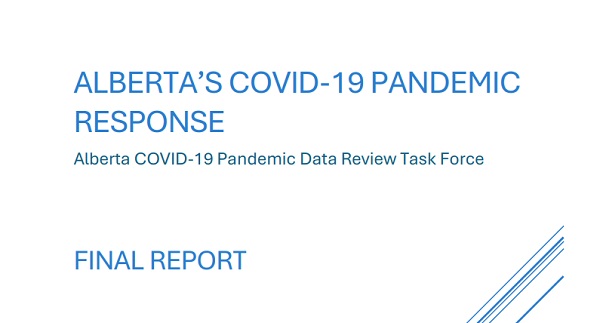Alberta
The Davidson Report critiquing the Government of Alberta’s COVID-19 pandemic response finally released: Dr David Speicher


Courageous Truth
Scientific facts, personal views and life’s journey
The Dr. Gary Davidson report has finally been released by the Government of Alberta and confirms big problems with public health and provides a roadmap for managing future pandemics.
Nearly six months after Dr. Gary Davidson’s report was submitted to Premier Danielle Smith, it was publicly released quietly by the Government of Alberta on their website.

The only public statement about the report was on Eric Bouchard’s X account: “Dr. Gary Davidson’s report brings Alberta one step closer to the truth. https://open.alberta.ca/publications/albertas-covid-19-pandemic-response”. Eric followed up by saying “Alberta now has a tremendous opportunity to right many of the wrongs that took place over the last few years. We must work together to heal humanity and to earn back the trust of all Albertans.” and “I am committed to working with Albertans to ensure that the historical pain caused by the response to COVID-19 does not repeat. Thank you, Dr. Davidson, for your incredible work to get this report out. I look forward to hearing Dr. Davidson live on March 3, 2025.”

Purpose:
On November 14, 2022, the Premier of Alberta established a Task Force under the Health Quality Council of Alberta to examine the quality, use, interpretation, and flow of information and data that informed Alberta’s pandemic response to COVID-19 and provide recommendations on how to better manage a future pandemic.
This report critiques the Government of Alberta’s response to the COVID-19 pandemic between 2020 and 2022. The report addresses 9 areas: governance and flow of information, regulatory bodies (e.g. the role of the College of Physicians and Surgeons of Alberta), modelling, non-pharmaceutical interventions, masking, testing, infection-acquired immunity, vaccines, and therapeutics. The task force attempted to remain neutral and examine information on both sides of the narrative. However, there was a “fundamental lack of transparency and willingness to reveal information and discuss decisions and actions taken by AHS during the pandemic.” and the task force found that there was “a lack of willingness on the part of AHS officials to cooperate with the Task Force in our requests for data and information.” [Pg 40-41]
Chapter 6: Testing
As a molecular virologist with expertise in the detection and surveillance of infectious diseases, the task force asked me to provide information and guidance on PCR, rapid antigen testing (RAT), and serological testing for SARS-CoV-2/COVID-19 during the pandemic. The report provides excellent background and the methods used to test people for SARS-CoV-2.
Unfortunately, I continue to see misinformation spread about the reliability of the PCR test, including the number of cycles and “97% false-positives”. Therefore, I will be providing a deep dive into the PCR test over the coming weeks, including presenting insight on one legal case where I served as an expert witness that asked whether or not a PCR test for COVID is a “genetic test” according to the Ontario labour code. I would be happy to answer any questions that people may have.
From The Davidson Report, I would like to highlight two key issues. The first is the classification of a COVID case being determined by a PCR-positive test result driving a “casedemic” rather than a “pandemic” and the second is regarding the millions of dollars wasted on unused PCR reagents and RATs.


It is important to note the following recommendations made regarding testing (P174):
- RT-PCR represents an excellent high-sensitivity test to aid in accurate diagnoses of symptomatic people – if they are used for the intended purpose and at optimal Ct values (vs. Ct values at “high positive” cut-offs).
- Rapid tests with reasonable accuracy should not be used for screening the general population but could be used as an additional diagnostic tool, where clinically indicated.
- We recommend that future pandemic responses prioritize minimizing severe disease and mortality over extensive case detection. Specifically, Alberta should focus on developing a screening tool to help estimate individual risk. This approach will optimize resource use by directing testing capacity, which can be appropriately directed by evidence-based practices, such as testing symptomatic individuals, those whose management may be influenced by test results, and for specific surveillance scenarios.
- We recommend that levels of immunity be gauged using a multi-antibody serological and/or mucosal assay that accounts for both pre-existing immunity as well as the presence of immune cells with the potential for cross-protection.
- All tests should also be professionally administered and sufficiently sensitive to detect low antibody levels while sufficiently specific to distinguish between target and non-target antibodies. This also applies to laboratory tests used to identify specific respiratory viruses. Individual risk estimates can then be used to inform individual needs for protection either through the use of personal protective measures and/or vaccination.
- Without being linked to a set of standardized clinical criteria, we recommend against the use of PCR tests as the sole criteria for a case definition. A confirmed case should include a pre-determined profile of signs and/or symptoms AND a positive test for the infection of concern PLUS any relevant patient history and confirmed epidemiological information.
- Ensure that local surveillance data are used and interpreted when determining strategy and policy.
Final Thoughts
Regarding the report, I think that it is a very well-written critique of the Government of Alberta’s response to the COVID-19 pandemic, but it is not a final conclusive report. This is a good start to opening the door for some important deep governmental discussions that need to happen, including diving deeper into the harms caused by the COVID-19 modRNA vaccines, like the DNA contamination and the presence of the SV40 promoter-enhancer nuclear localization sequences, the vast number of vaccine-injured people, and the increased risk of turbo cancer. While I am disappointed that the Government of Alberta, namely Premier Smith, tried to bury this report by sitting on it for six months and quietly releasing the report without a proper press conference on the week of the USA inauguration I am relieved to see that the report was finally made public. The government’s attempt to bury the report shows that this is indeed a damning report and the government’s response could have been much better. However, I hope that this report will bring about government transparency and begin that well-needed conversation so that our society can indeed heal.
Healing Humanity is the theme of the next An Injection of Truth happening on March 3, 2025 in Calgary, Alberta. During the event I will be sharing on the numerous ways the COVID-19 vaccines can potentially cause harm and what can be done to heal from those harms. I will share the stage with several other prominent scientists.
- Dr. Byram Bridle who has also shared his insights on The Davidson Report and will be “exposing lies from public health agencies that contributed to a myriad of problems within the pandemic response.”
- Dr. Gary Davidson will be presenting on the contents the report by the Alberta COVID-19 Pandemic Data Review Task Force.
- Dr. Denis Rancourt will provide a deep dive into the all-cause mortality.
- Dr. David Martin will definitely be a presenter that no one will want to miss.
In closing, I encourage everyone to read through The Davidson Report and post your thoughts on the report in the comments section. What did you like or disagree with? What would you like to see different next time? I would be happy to take your comments to Calgary in March 2025. I also hope that this will be one of many governmental task forces that take a deep dive into the governmental response to the pandemic. We desperately need one for each province and at the federal level.

Alberta
Schools should go back to basics to mitigate effects of AI

From the Fraser Institute
Odds are, you can’t tell whether this sentence was written by AI. Schools across Canada face the same problem. And happily, some are finding simple solutions.
Manitoba’s Division Scolaire Franco-Manitobaine recently issued new guidelines for teachers, to only assign optional homework and reading in grades Kindergarten to six, and limit homework in grades seven to 12. The reason? The proliferation of generative artificial intelligence (AI) chatbots such as ChatGPT make it very difficult for teachers, juggling a heavy workload, to discern genuine student work from AI-generated text. In fact, according to Division superintendent Alain Laberge, “Most of the [after-school assignment] submissions, we find, are coming from AI, to be quite honest.”
This problem isn’t limited to Manitoba, of course.
Two provincial doors down, in Alberta, new data analysis revealed that high school report card grades are rising while scores on provincewide assessments are not—particularly since 2022, the year ChatGPT was released. Report cards account for take-home work, while standardized tests are written in person, in the presence of teaching staff.
Specifically, from 2016 to 2019, the average standardized test score in Alberta across a range of subjects was 64 while the report card grade was 73.3—or 9.3 percentage points higher). From 2022 and 2024, the gap increased to 12.5 percentage points. (Data for 2020 and 2021 are unavailable due to COVID school closures.)
In lieu of take-home work, the Division Scolaire Franco-Manitobaine recommends nightly reading for students, which is a great idea. Having students read nightly doesn’t cost schools a dime but it’s strongly associated with improving academic outcomes.
According to a Programme for International Student Assessment (PISA) analysis of 174,000 student scores across 32 countries, the connection between daily reading and literacy was “moderately strong and meaningful,” and reading engagement affects reading achievement more than the socioeconomic status, gender or family structure of students.
All of this points to an undeniable shift in education—that is, teachers are losing a once-valuable tool (homework) and shifting more work back into the classroom. And while new technologies will continue to change the education landscape in heretofore unknown ways, one time-tested winning strategy is to go back to basics.
And some of “the basics” have slipped rapidly away. Some college students in elite universities arrive on campus never having read an entire book. Many university professors bemoan the newfound inability of students to write essays or deconstruct basic story components. Canada’s average PISA scores—a test of 15-year-olds in math, reading and science—have plummeted. In math, student test scores have dropped 35 points—the PISA equivalent of nearly two years of lost learning—in the last two decades. In reading, students have fallen about one year behind while science scores dropped moderately.
The decline in Canadian student achievement predates the widespread access of generative AI, but AI complicates the problem. Again, the solution needn’t be costly or complicated. There’s a reason why many tech CEOs famously send their children to screen-free schools. If technology is too tempting, in or outside of class, students should write with a pencil and paper. If ChatGPT is too hard to detect (and we know it is, because even AI often can’t accurately detect AI), in-class essays and assignments make sense.
And crucially, standardized tests provide the most reliable equitable measure of student progress, and if properly monitored, they’re AI-proof. Yet standardized testing is on the wane in Canada, thanks to long-standing attacks from teacher unions and other opponents, and despite broad support from parents. Now more than ever, parents and educators require reliable data to access the ability of students. Standardized testing varies widely among the provinces, but parents in every province should demand a strong standardized testing regime.
AI may be here to stay and it may play a large role in the future of education. But if schools deprive students of the ability to read books, structure clear sentences, correspond organically with other humans and complete their own work, they will do students no favours. The best way to ensure kids are “future ready”—to borrow a phrase oft-used to justify seesawing educational tech trends—is to school them in the basics.
Alberta
Alberta’s new diagnostic policy appears to meet standard for Canada Health Act compliance

From the Fraser Institute
By Nadeem Esmail, Mackenzie Moir and Lauren Asaad
In October, Alberta’s provincial government announced forthcoming legislative changes that will allow patients to pay out-of-pocket for any diagnostic test they want, and without a physician referral. The policy, according to the Smith government, is designed to help improve the availability of preventative care and increase testing capacity by attracting additional private sector investment in diagnostic technology and facilities.
Unsurprisingly, the policy has attracted Ottawa’s attention, with discussions now taking place around the details of the proposed changes and whether this proposal is deemed to be in line with the Canada Health Act (CHA) and the federal government’s interpretations. A determination that it is not, will have both political consequences by being labeled “non-compliant” and financial consequences for the province through reductions to its Canada Health Transfer (CHT) in coming years.
This raises an interesting question: While the ultimate decision rests with Ottawa, does the Smith government’s new policy comply with the literal text of the CHA and the revised rules released in written federal interpretations?
According to the CHA, when a patient pays out of pocket for a medically necessary and insured physician or hospital (including diagnostic procedures) service, the federal health minister shall reduce the CHT on a dollar-for-dollar basis matching the amount charged to patients. In 2018, Ottawa introduced the Diagnostic Services Policy (DSP), which clarified that the insured status of a diagnostic service does not change when it’s offered inside a private clinic as opposed to a hospital. As a result, any levying of patient charges for medically necessary diagnostic tests are considered a violation of the CHA.
Ottawa has been no slouch in wielding this new policy, deducting some $76.5 million from transfers to seven provinces in 2023 and another $72.4 million in 2024. Deductions for Alberta, based on Health Canada’s estimates of patient charges, totaled some $34 million over those two years.
Alberta has been paid back some of those dollars under the new Reimbursement Program introduced in 2018, which created a pathway for provinces to be paid back some or all of the transfers previously withheld on a dollar-for-dollar basis by Ottawa for CHA infractions. The Reimbursement Program requires provinces to resolve the circumstances which led to patient charges for medically necessary services, including filing a Reimbursement Action Plan for doing so developed in concert with Health Canada. In total, Alberta was reimbursed $20.5 million after Health Canada determined the provincial government had “successfully” implemented elements of its approved plan.
Perhaps in response to the risk of further deductions, or taking a lesson from the Reimbursement Action Plan accepted by Health Canada, the province has gone out of its way to make clear that these new privately funded scans will be self-referred, that any patient paying for tests privately will be reimbursed if that test reveals a serious or life-threatening condition, and that physician referred tests will continue to be provided within the public system and be given priority in both public and private facilities.
Indeed, the provincial government has stated they do not expect to lose additional federal health care transfers under this new policy, based on their success in arguing back previous deductions.
This is where language matters: Health Canada in their latest CHA annual report specifically states the “medical necessity” of any diagnostic test is “determined when a patient receives a referral or requisition from a medical practitioner.” According to the logic of Ottawa’s own stated policy, an unreferred test should, in theory, be no longer considered one that is medically necessary or needs to be insured and thus could be paid for privately.
It would appear then that allowing private purchase of services not referred by physicians does pass the written standard for CHA compliance, including compliance with the latest federal interpretation for diagnostic services.
But of course, there is no actual certainty here. The federal government of the day maintains sole and final authority for interpretation of the CHA and is free to revise and adjust interpretations at any time it sees fit in response to provincial health policy innovations. So while the letter of the CHA appears to have been met, there is still a very real possibility that Alberta will be found to have violated the Act and its interpretations regardless.
In the end, no one really knows with any certainty if a policy change will be deemed by Ottawa to run afoul of the CHA. On the one hand, the provincial government seems to have set the rules around private purchase deliberately and narrowly to avoid a clear violation of federal requirements as they are currently written. On the other hand, Health Canada’s attention has been aroused and they are now “engaging” with officials from Alberta to “better understand” the new policy, leaving open the possibility that the rules of the game may change once again. And even then, a decision that the policy is permissible today is not permanent and can be reversed by the federal government tomorrow if its interpretive whims shift again.
The sad reality of the provincial-federal health-care relationship in Canada is that it has no fixed rules. Indeed, it may be pointless to ask whether a policy will be CHA compliant before Ottawa decides whether or not it is. But it can be said, at least for now, that the Smith government’s new privately paid diagnostic testing policy appears to have met the currently written standard for CHA compliance.

Lauren Asaad
Policy Analyst, Fraser Institute
-

 Censorship Industrial Complex21 hours ago
Censorship Industrial Complex21 hours agoDeath by a thousand clicks – government censorship of Canada’s internet
-

 Daily Caller22 hours ago
Daily Caller22 hours agoChinese Billionaire Tried To Build US-Born Baby Empire As Overseas Elites Turn To American Surrogates
-

 Great Reset24 hours ago
Great Reset24 hours agoViral TikTok video shows 7-year-old cuddling great-grandfather before he’s euthanized
-

 Automotive1 day ago
Automotive1 day agoPoliticians should be honest about environmental pros and cons of electric vehicles
-

 Digital ID20 hours ago
Digital ID20 hours agoCanada releases new digital ID app for personal documents despite privacy concerns
-

 Community17 hours ago
Community17 hours agoCharitable giving on the decline in Canada
-

 Alberta23 hours ago
Alberta23 hours agoSchools should go back to basics to mitigate effects of AI
-

 Bruce Dowbiggin19 hours ago
Bruce Dowbiggin19 hours agoNFL Ice Bowls Turn Down The Thermostat on Climate Change Hysteria





